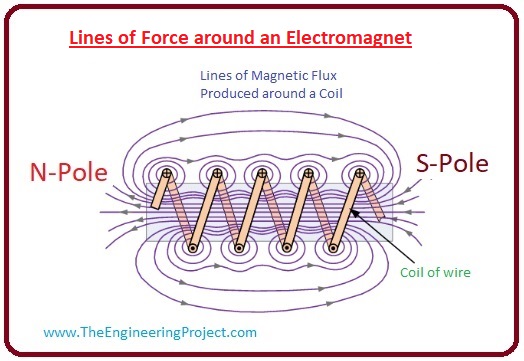
What is Electromagnet
- The variety of magnet that used current for the generation of the magnetic field is known as the electromagnet.
- These magnets are formed by the wire when it rapped like a loop and current passes through this loop.
- When current passes through the coil magnetic field around the coil produced in a circular shape, its density at the centre of the loop is high and as moves away from the coil it strength decreases.
- Mostly used conductor for the electromagnet is iron because it concentrates the flux produced by the current at the centre and make high power electromagnet.
- The benefit of the electromagnet over the permanent magnet is that we can control its durability and magnetic field by adjusting the current, but in permanent magnet, it is not possible.
- But it also has a drawback that for continue acting it needs a power supply but in the permanent magnet is not needed.
- The electromagnets are frequently used in all classes of electrical machines like motor, generator, speaker and magnetic imaging machine in the hospital.

Lines of Force around an Electromagnet
- When the current passes through the wire it behaves like an electromagnet due to this current magnetic field is produced around the conductor.
- This field has its own north and south poles, it starts from the north pole and end at the south field. The strength of the field is higher at the centre of the loop of the wire and strength decreases as moves away from the centre.
- If we wound more loops of the windings around the iron piece than the strength of the field can be increased.
- From this, we can conclude that the flux of any conductor is directly proportioned the amount of current passing through it and its number of the turns.
m.m.f = I x N
Magnetic Strength of the Electromagnet
- When the electromagnet is created then there are 2 conductors are used first one is wire loop and other is conductor whose around the loop is wound.
- When the current passes through these conductors magnetic field produced in both the conductors and these fields interact with one another and force act on these 2 conductors.
- If the current passing through both the conductors has a similar direction then the conductors will have attraction among them you can see it in the above diagram.
- When the direction of the current is opposite then the field of 2 conductors become strong and both of them repel each other.
- The strength of the field around the conductor depends on the distance from the conductor, it becomes weaker as moves away from the conductor.
- The field strength can be defined by the given formula.
- H = (I x N)/L
Permeability of Electromagnets
- If we use the core of different conductors instead of the iron than the capacity of the magnet will be different for different core material.
- The changing in the power electromagnet is due to the variation in the density of the flux, different materials produce different flux.
- The more flux lines can pass through the core then the material has larger permeability.
- The formula for the permeability of the material is given as.
u = ur x uo
- In this equation, u is the permeability of the core material.
- ur is the relative permeability of the material.
- uo permeability of the free space.
Advantages of an Electromagnet Over a Permanent Magnet
- These are the main benefits that we get from electromagnet that is not provided by the permanent magnet.
Control of Magnet Strength
- The most important feature of the electromagnet is that the magnetic strength of it can be varied.
- If the current is not passing through the windings of the electromagnt than it works as an insulator when current passes through it becomes a magnet.
- If the current provided in large amperes than there is a larger increment in the strength of the magnet.
- This ability variation in the strength of the electromagnetic makes it useful in industries where the different value of the flux is needed.
Applications of the Electromagnets
- There are many applications of the electromagnets in the industries, home and also in medical equipment. Let's discuss these applications.
- It used in heavy types of machinery used in factories, and smaller electronic instruments like motors.
- It also used for different experiments for the production of the magnetic field.
- If the electromagnet is in the form of the solenoids, it used for the creation of the uniform magnetic field.
- It used in transformer for the production of the flux in the transformer, the core of the transformer behaves like an electromagnet.
- It used in different electrical relays.
- The working of the loudspeaker used in the seminar also depends on the electromagnet.
- Medical resonance imaging machine also used for the production of the magnetic field.
- It also used in hard disks VCR (videocassette recorder), and tape recorder.





